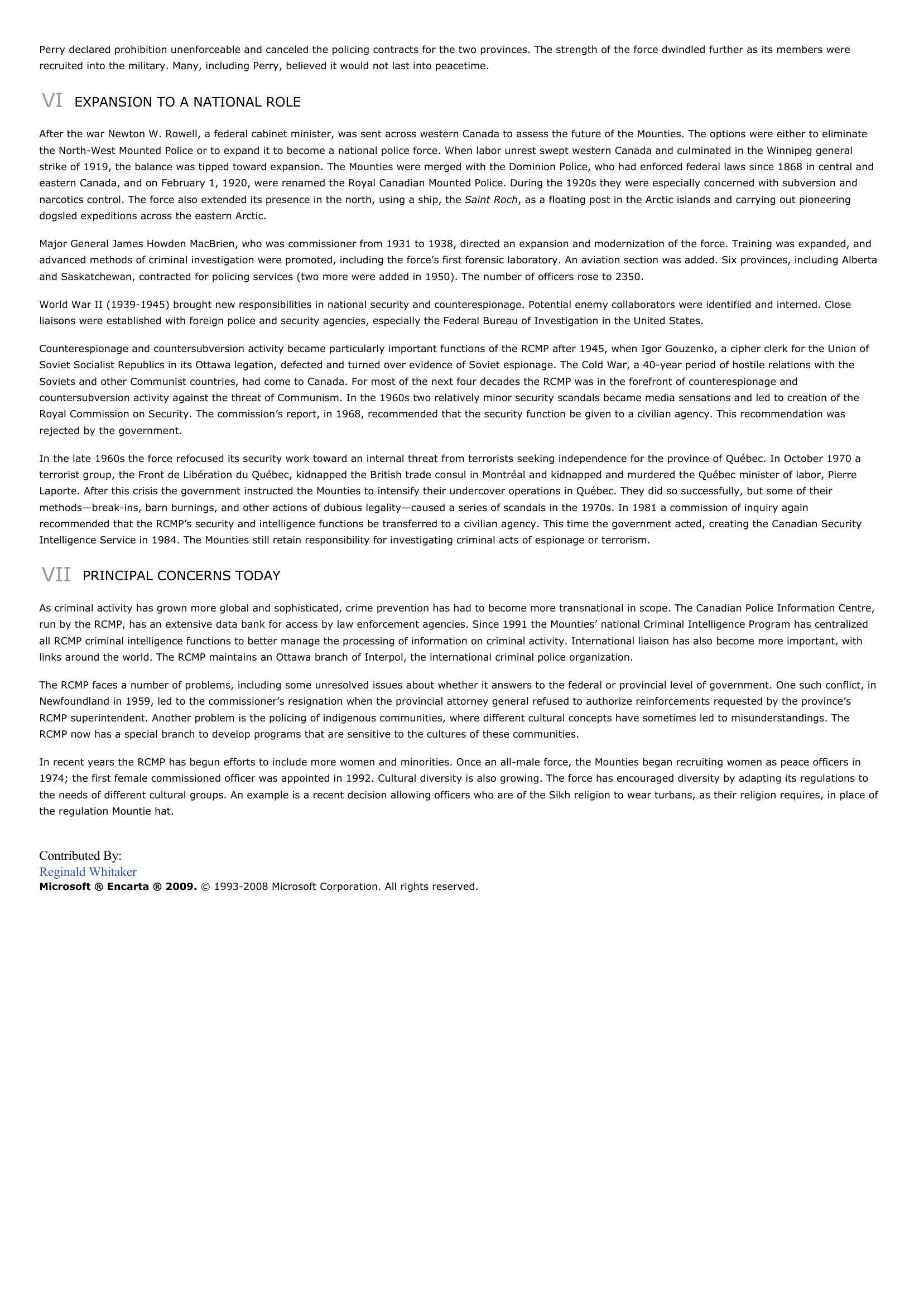Royal Canadian Mounted Police.
Publié le 10/05/2013

Extrait du document
«
Perry declared prohibition unenforceable and canceled the policing contracts for the two provinces.
The strength of the force dwindled further as its members wererecruited into the military.
Many, including Perry, believed it would not last into peacetime.
VI EXPANSION TO A NATIONAL ROLE
After the war Newton W.
Rowell, a federal cabinet minister, was sent across western Canada to assess the future of the Mounties.
The options were either to eliminatethe North-West Mounted Police or to expand it to become a national police force.
When labor unrest swept western Canada and culminated in the Winnipeg generalstrike of 1919, the balance was tipped toward expansion.
The Mounties were merged with the Dominion Police, who had enforced federal laws since 1868 in central andeastern Canada, and on February 1, 1920, were renamed the Royal Canadian Mounted Police.
During the 1920s they were especially concerned with subversion andnarcotics control.
The force also extended its presence in the north, using a ship, the Saint Roch , as a floating post in the Arctic islands and carrying out pioneering dogsled expeditions across the eastern Arctic.
Major General James Howden MacBrien, who was commissioner from 1931 to 1938, directed an expansion and modernization of the force.
Training was expanded, andadvanced methods of criminal investigation were promoted, including the force’s first forensic laboratory.
An aviation section was added.
Six provinces, including Albertaand Saskatchewan, contracted for policing services (two more were added in 1950).
The number of officers rose to 2350.
World War II (1939-1945) brought new responsibilities in national security and counterespionage.
Potential enemy collaborators were identified and interned.
Closeliaisons were established with foreign police and security agencies, especially the Federal Bureau of Investigation in the United States.
Counterespionage and countersubversion activity became particularly important functions of the RCMP after 1945, when Igor Gouzenko, a cipher clerk for the Union ofSoviet Socialist Republics in its Ottawa legation, defected and turned over evidence of Soviet espionage.
The Cold War, a 40-year period of hostile relations with theSoviets and other Communist countries, had come to Canada.
For most of the next four decades the RCMP was in the forefront of counterespionage andcountersubversion activity against the threat of Communism.
In the 1960s two relatively minor security scandals became media sensations and led to creation of theRoyal Commission on Security.
The commission’s report, in 1968, recommended that the security function be given to a civilian agency.
This recommendation wasrejected by the government.
In the late 1960s the force refocused its security work toward an internal threat from terrorists seeking independence for the province of Québec.
In October 1970 aterrorist group, the Front de Libération du Québec, kidnapped the British trade consul in Montréal and kidnapped and murdered the Québec minister of labor, PierreLaporte.
After this crisis the government instructed the Mounties to intensify their undercover operations in Québec.
They did so successfully, but some of theirmethods—break-ins, barn burnings, and other actions of dubious legality—caused a series of scandals in the 1970s.
In 1981 a commission of inquiry againrecommended that the RCMP’s security and intelligence functions be transferred to a civilian agency.
This time the government acted, creating the Canadian SecurityIntelligence Service in 1984.
The Mounties still retain responsibility for investigating criminal acts of espionage or terrorism.
VII PRINCIPAL CONCERNS TODAY
As criminal activity has grown more global and sophisticated, crime prevention has had to become more transnational in scope.
The Canadian Police Information Centre,run by the RCMP, has an extensive data bank for access by law enforcement agencies.
Since 1991 the Mounties’ national Criminal Intelligence Program has centralizedall RCMP criminal intelligence functions to better manage the processing of information on criminal activity.
International liaison has also become more important, withlinks around the world.
The RCMP maintains an Ottawa branch of Interpol, the international criminal police organization.
The RCMP faces a number of problems, including some unresolved issues about whether it answers to the federal or provincial level of government.
One such conflict, inNewfoundland in 1959, led to the commissioner’s resignation when the provincial attorney general refused to authorize reinforcements requested by the province’sRCMP superintendent.
Another problem is the policing of indigenous communities, where different cultural concepts have sometimes led to misunderstandings.
TheRCMP now has a special branch to develop programs that are sensitive to the cultures of these communities.
In recent years the RCMP has begun efforts to include more women and minorities.
Once an all-male force, the Mounties began recruiting women as peace officers in1974; the first female commissioned officer was appointed in 1992.
Cultural diversity is also growing.
The force has encouraged diversity by adapting its regulations tothe needs of different cultural groups.
An example is a recent decision allowing officers who are of the Sikh religion to wear turbans, as their religion requires, in place ofthe regulation Mountie hat.
Contributed By:Reginald WhitakerMicrosoft ® Encarta ® 2009. © 1993-2008 Microsoft Corporation.
All rights reserved..
»
↓↓↓ APERÇU DU DOCUMENT ↓↓↓
Liens utiles
- Royal Proclamation of 1763 - Canadian History.
- Sur les traces du ROYAL BEARN
- Bocage royal : Fiche de lecture
- PORT ROYAL d'Henry de Montherlant (résumé & analyse)
- PORT-ROYAL de Montherlant (résumé & analyse)









